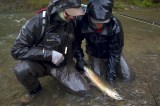Oregon to Continue Wild Steelhead Harvest Despite Dismal Returns

It is no secret that the wild steelhead populations of the Pacific Northwest are struggling. Warming oceans, over-harvest, increasing predator abundance, habitat loss, and dams have wreaked havoc on the iconic anadromous species in recent years, to the point that there are only four wild steelhead population segments in the Lower 48 that aren’t currently listed under the Endangered Species Act: the Olympic Peninsula, Klamath Mountains, Southwest Washington, and the Oregon Coast. The Oregon Coast population is split between the Northwest Zone and the Southwest Zone, two areas through which most anadromous fishes enter Oregon.
This summer, the Northwest Zone saw some of the lowest steelhead returns since record-keeping began in 1938. Approximately 67,750 steelhead were counted at the Bonneville Dam, a large barrier 40 miles east of Portland built in the 1930s that spans the Columbia River between Oregon and Washington at river mile 146.1. This number is down 30% from recent years and is nearly one-third of the 10-year average of approximately 175,100 fish. As recently as 2001 the run averaged approximately 378,000 steelhead. At the time of writing, several of the tributaries in the Columbia basin remain completely closed to fishing in order to ensure summer steelhead safe passage to their spawning grounds.
On the other hand, it is nearly impossible to say exactly how well the steelhead runs in the Southwest Zone are doing. As of 2021, ODFW had no management plan in place for eight of the 10 river systems within the zone. The dismal steelhead return in the Northwest Zone coupled with this lack of data has led to an outcry from anglers and conservation groups, both of whom are calling for a tightening of measures in the Southwest Zone until the reasons for the overall decline are understood.
The lack of action by ODFW has led to some anglers taking conservation efforts into their own hands. Chase White, a photographer and fisherman, created a concept called #OneandDone, meaning once you’ve caught and released one wild steelhead, you choose to call it a day. A petition calling to end the harvest of wild steelhead in Southern Oregon by the Native Fish Society garnered more than 400 signatures.
Some long-term guides like Jeff Hickman on the Deschutes chose to cancel their entire fall season this year, citing, “terrible run numbers, high water temperatures, and continued mismanagement by ODFW and [Pacific Gas and Electric].”
He continued, “I don’t feel conducting our regular business this year is ethical. The risk of killing even one wild steelhead is too many. The river has none to spare.”
Later, ODFW closed the Lower Deschutes to steelhead fishing for the entire month of September, citing high water temperatures and low flows.
For the last several months, ODFW has been meeting to discuss the region's strategy, the “Rogue-South Coast Multi-Species Conservation and Management Plan.” It creates a large network for wild fish emphasis areas in southwest Oregon and continues to allow conservative wild winter steelhead harvest, according to the department. Critics of the plan say that wild steelhead harvest should be suspended completely in the region, at least for the time being.
One such critic is Justin Gindlesperger, the southwest regional director for the Oregon Chapter of Backcountry Hunters & Anglers. “Considering the low returns across the state, impacts of severe droughts and reduced river flows, OR BHA feels it is in the best interest to take a precautionary approach to protect these iconic fish before the populations decline severely,” he said. “By implementing a catch-and-release alternative, we can protect wild steelhead while still providing fishing opportunities and continued take of hatchery fish.”
Without adequate monitoring data, there is no way to know the impacts of the harvest of wild fish on adult populations, Gindlesperger said.
“In other areas throughout the Pacific Northwest, fisheries managers have implemented catch-and-release regulations in the absence of good, empirical data,” he said. “This includes the majority of rivers in Oregon outside of the southwest, [as well as] Idaho, California, and most recently Washington.”
More than 150 people offered comments to ODFW on the plan, many of whom expressed similar concerns regarding the retention of wild steelhead without proper data. Despite this, the Oregon Fish and Wildlife Commission voted 5-2 to continue the harvest of wild steelhead rather than instituting catch-and-release measures.
According to ODFW, “Two stakeholder teams worked for nearly two years helping ODFW develop the plan. Adoption of the staff recommended alternative reflects the stakeholder team process and was a compromise between what various stakeholders recommended. Since poor summer steelhead returns may persist in the near-term, fish biologists across the region will be coordinating on future protective measures while considering equitable sharing of the conservation burden.”
Despite the continuation of wild steelhead retention, the new plan does seek to improve steelhead numbers and habitat. ODFW says that will include a robust climate change analysis, habitat strategies and actions to minimize climate change impacts, significant outreach and coordination efforts on many aspects of the plan, new fishing authorizations required for winter steelhead angling, and significant new monitoring efforts throughout the planning area.
Regarding the decision, Gindlesperger said his group was “disappointed with the final vote to maintain the status quo. BHA supports the North American Model of Conservation and science-based decisions, and since there is a total lack of data on why this year’s run was so low, why don’t we throttle back a bit until we do have that data?”






Conversation